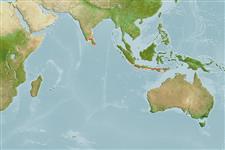Teleostei (teleosts) >
Anguilliformes (Eels and morays) >
Muraenidae (Moray eels) > Muraeninae
Etymology: Diaphenchelys: Name from Greek 'diaphoros' meaning different and 'enchelys' for eel; referring to the anatomical characteristics and the unusual habitat (mud dweller) preference of the type species; pelonates: Name from Greek 'pelos' for mud and 'nates' for dweller, refers to its mud-dwelling habit; noun in apposition.
More on authors: McCosker & Randall.
Environment: milieu / climate zone / depth range / distribution range
Ecology
Marine; demersal; depth range 15 - 32 m (Ref. 75775). Tropical
Western Pacific: Indonesia.
Size / Weight / Age
Maturity: Lm ? range ? - ? cm
Max length : 46.5 cm TL male/unsexed; (Ref. 75775)
Short description
Identification keys | Morphology | Morphometrics
Vertebrae: 155. This species is small, elongate, slender, brown moray has white spots and vermiculations on the head behind the rictus and extends into the anterior trunk; pale margins posteriorly on fins; anus before midbody; length of preanal 2.5-2.6 in TL; gill opening depth 33-35 in TL; head 10-11 in TL; short snout, rear margin of orbit above middle or eye; jaws moderately long, not recurved; conical teeth, some needle-like; biserial maxillary teeth, those on outer row smaller and closely spaced; mostly uniserial mandibular teeth, outer row smaller and closely spaced; MVF 6/56/154 (Ref,. 75775).
Found on mud bottom with scattered rocks in 15-32 m (Ref. 90102).
Life cycle and mating behavior
Maturity | Reproduction | Spawning | Eggs | Fecundity | Larvae
McCosker, J.E. and J.E. Randall, 2007. A new genus and species of mud-dwelling moray eel (Anguilliformes: Muraenidae) from Indonesia. Proc. Calif. Acad. Sci. 58(22):469-476. (Ref. 75775)
IUCN Red List Status (Ref. 130435: Version 2024-2)
Threat to humans
Harmless
Human uses
Fisheries: of no interest
Tools
Special reports
Download XML
Internet sources
Estimates based on models
Phylogenetic diversity index (Ref.
82804): PD
50 = 1.0000 [Uniqueness, from 0.5 = low to 2.0 = high].
Bayesian length-weight: a=0.00049 (0.00024 - 0.00099), b=3.26 (3.10 - 3.42), in cm total length, based on LWR estimates for this (Sub)family-body shape (Ref.
93245).
Trophic level (Ref.
69278): 3.9 ±0.6 se; based on size and trophs of closest relatives
Resilience (Ref.
120179): Medium, minimum population doubling time 1.4 - 4.4 years (Preliminary K or Fecundity.).
Fishing Vulnerability (Ref.
59153): Moderate vulnerability (37 of 100).
